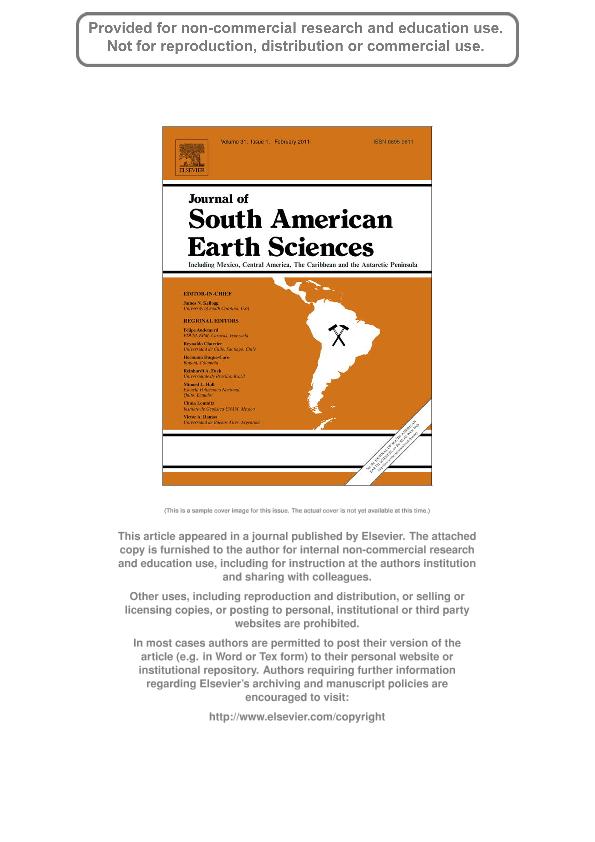Artículo
Age and magmatic evolution of the Famatinian granitic rocks of Sierra de Ancasti, Sierras Pampeanas, NW Argentina
Dahlquist, Juan Andrés ; Rapela, Carlos Washington
; Rapela, Carlos Washington ; Pankhurst, Robert J.; Fanning, C. Mark; Vervoort, Jeffrey D.; Hart, Garret; Baldo, Edgardo Gaspar Agustín
; Pankhurst, Robert J.; Fanning, C. Mark; Vervoort, Jeffrey D.; Hart, Garret; Baldo, Edgardo Gaspar Agustín ; Murra, Juan Alberto Félix
; Murra, Juan Alberto Félix ; Alasino, Pablo Horacio
; Alasino, Pablo Horacio ; Colombo, Fernando
; Colombo, Fernando
 ; Rapela, Carlos Washington
; Rapela, Carlos Washington ; Pankhurst, Robert J.; Fanning, C. Mark; Vervoort, Jeffrey D.; Hart, Garret; Baldo, Edgardo Gaspar Agustín
; Pankhurst, Robert J.; Fanning, C. Mark; Vervoort, Jeffrey D.; Hart, Garret; Baldo, Edgardo Gaspar Agustín ; Murra, Juan Alberto Félix
; Murra, Juan Alberto Félix ; Alasino, Pablo Horacio
; Alasino, Pablo Horacio ; Colombo, Fernando
; Colombo, Fernando
Fecha de publicación:
03/2012
Editorial:
Pergamon-Elsevier Science Ltd
Revista:
Journal of South American Earth Sciences
ISSN:
0895-9811
Idioma:
Inglés
Tipo de recurso:
Artículo publicado
Clasificación temática:
Resumen
The granitic rocks of the Sierra de Ancasti represent one of the easternmost outcrops of the Famatinian arc of the Sierras Pampeanas. We report here new U-Pb SHRIMP and LA-ICP-MS Ordovician ages and a petrological and geochemical study of the Las Cañadas I-type granitic complex in the central sector of Sierra de Ancasti. Numerical modelling indicates that calc-alkaline and metaluminous monzogranites (SiO 2=69.8-73.0wt.%) were produced by fractional crystallization of plagioclase-rich tonalite (∼60% plagioclase and SiO 2=60.9-62.5wt.%) from an inferred parental magma of granodioritic composition (SiO 2=67.4wt.%). Sm-Nd isotopic data on the dated rocks indicate a dominant continental crustal input, as reported for other Ordovician granitic rocks (Famatinian magmatism) farther west in the Sierras Pampeanas. Combined ages and isotopic data are consistent with previous studies indicating that Famatinian magmatism was short-lived (∼20Ma) and lacked a significant asthenospheric contribution. The occurrence of inherited zircon and the petrological and geochemical data from the Las Cañadas complex indicate that the parental magma was derived from mixed igneous and sedimentary material in the source or by partial melting of igneous rocks of different ages. Systematic dating of inherited zircon cores is required to clarify this issue. Zircon saturation geothermometry combined with geochemical data indicates that the onset of zircon crystallization, together with variable amounts of other minerals such as plagioclase, quartz, biotite, oxides and apatite, occurred when the parental magma reached 67wt.% SiO 2 with ∼440ppm of Zr at ∼878°C.
Archivos asociados
Licencia
Identificadores
Colecciones
Articulos(CICTERRA)
Articulos de CENTRO DE INVEST.EN CS.DE LA TIERRA
Articulos de CENTRO DE INVEST.EN CS.DE LA TIERRA
Citación
Dahlquist, Juan Andrés; Rapela, Carlos Washington; Pankhurst, Robert J.; Fanning, C. Mark; Vervoort, Jeffrey D.; et al.; Age and magmatic evolution of the Famatinian granitic rocks of Sierra de Ancasti, Sierras Pampeanas, NW Argentina; Pergamon-Elsevier Science Ltd; Journal of South American Earth Sciences; 34; 3-2012; 10-25
Compartir
Altmétricas



